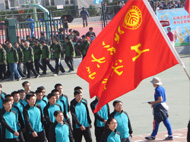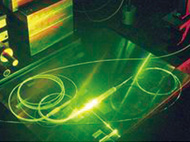题目:Nano-indentation and stress-induced phase transformation in Ni-Ti-Fe shape memory alloys
报告人: Dr. Jiancun RAO
Department of Materials Science, Ruhr University Bochum,
Bochum 44781, Germany
主持人:郑玉峰 教授
时间:2008年9月1日(周一)14:00
地点:力学楼434会议室
报告内容摘要:
The present study shows that stress-induced martensite forms during nanoindentation of a pseudoelastic shape memory alloy of type Ti50Ni48Fe2. For this purpose, nanoindentation experiments were performed by using a specimen which was prepared for subsequent investigation in a transmission electron microscope (TEM). A Berkovich nanoindentation experiment into the thin part of the TEM specimen and subsequent post-mortem TEM analysis (bright ?eld and selected area diffraction) showed that B19’ martensite phase forms close to the center of the indent (distance d from the center of the indent <2 μm). Further out (2 μm< d <5 μm), an increased dislocation density was observed. This represents direct microstructural evidence for the formation of stress-induced martensite and a simultaneous increase in dislocation density during Berkovich nanoindentation of pseudoelastic shape memory alloys.
欢迎广大老师和研究生参加!
报告人简介:Biographical Sketch of Dr. Jiancun RAO
Dr. Jiancun RAO is now a research scientist at Ruhr University Bochum, Germany. He was an associate professor at Harbin Institute of Technology before his leaving, where he received his Ph.D. in 2001. He spent one year as a visiting scholar at Department of Physics, the Hong Kong University of Science and Technology; half year as post-doctoral researcher at Kumamoto University in Japan; and near 3 years as research associate at National Institute of Materials Science (NIMS) of Japan. Then he moved to Europe in 2006. Before he went to Germany, he worked and studied at EMAT, Department of Physics at University of Antwerp in Belgium for one year, which is a world famous TEM laboratory and research center. He is primarily known for his work on microstructure characterization of materials, including metals, alloys, ceramics and mesoporous materials. He found two new phases in yittria stabilized zirconia ceramics and explained the intrinsic reason of slope change of load-displacement curves in nanoindentation experiments in Ni-Ti shape memory alloys.









